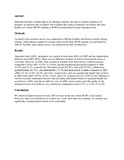Antenatal And Delivery Care In Rural Western Kenya: The Effect Of Training Health Care Workers To Provide "focused Antenatal Care

View/
Date
2010Author
Ouma, Peter O
Eijk, Anna M van
Hamel, Mary J
Sikuku, Evallyne S
Odhiambo, Frank O
Munguti, Kaendi M
Ayisi, John G
Sara, Crawford
Kager, Piet A
Slutsker, Laurence
Type
ArticleLanguage
enMetadata
Show full item recordAbstract
Maternal mortality remains high in developing countries and data to monitor indicators of progress in maternal care is needed. We examined the status of maternal care before and after health care worker (HCW) training in WHO recommended Focused Antenatal Care.
Methods
An initial cross-sectional survey was conducted in 2002 in Asembo and Gem in western Kenya among a representative sample of women with a recent birth. HCW training was performed in 2003 in Asembo, and a repeat survey was conducted in 2005 in both areas.
Results
Antenatal clinic (ANC) attendance was similar in both areas (86%) in 2005 and not significantly different from 2002 (90%). There was no difference in place of delivery between the areas or over time. However, in 2005, more women in Asembo were delivered by a skilled assistant compared to Gem (30% vs.23%, P = 0.04), and this proportion increased compared to 2002 (17.6% and 16.1%, respectively). Provision of iron (82.4%), folic acid (72.0%), sulfadoxine-pyrimethamine (61.7%), and anthelminths (12.7%) had increased in Asembo compared to 2002 (2002: 53.3%, 52.8%, 20.3%, and 4.6%, respectively), and was significantly higher than in Gem in 2005 (Gem 2005: 69.7%, 47.8%, 19.8%, and 4.1%, respectively) (P < 0.05 for all). Offering of tests for sexually transmitted diseases and providing information related to maternal health was overall low (<20%) and did not differ by area. In 2005, more women rated the quality of the antenatal service in Asembo as very satisfactory compared to Gem (17% vs. 6.5%, P < 0.05).
Conclusions
We observed improvements in some ANC services in the area where HCWs were trained. However, since our evaluation was carried out 2 years after three-day training, we consider any significant, sustained improvement to be remarkable.
Publisher
University of Nairobi,
